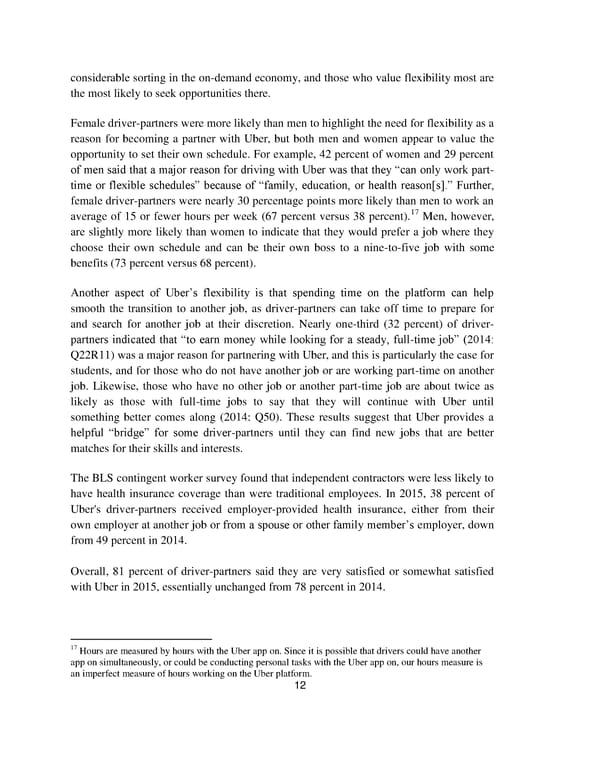considerable sorting in the on-demand economy, and those who value flexibility most are the most likely to seek opportunities there. Female driver-partners were more likely than men to highlight the need for flexibility as a reason for becoming a partner with Uber, but both men and women appear to value the opportunity to set their own schedule. For example, 42 percent of women and 29 percent of men said that a major reason for driving with Uber was that they “can only work part- time or flexible schedules” because of “family, education, or health reason[s].” Further, female driver-partners were nearly 30 percentage points more likely than men to work an average of 15 or fewer hours per week (67 percent versus 38 percent).17 Men, however, are slightly more likely than women to indicate that they would prefer a job where they choose their own schedule and can be their own boss to a nine-to-five job with some benefits (73 percent versus 68 percent). Another aspect of Uber’s flexibility is that spending time on the platform can help smooth the transition to another job, as driver-partners can take off time to prepare for and search for another job at their discretion. Nearly one-third (32 percent) of driver- partners indicated that “to earn money while looking for a steady, full-time job” (2014: Q22R11) was a major reason for partnering with Uber, and this is particularly the case for students, and for those who do not have another job or are working part-time on another job. Likewise, those who have no other job or another part-time job are about twice as likely as those with full-time jobs to say that they will continue with Uber until something better comes along (2014: Q50). These results suggest that Uber provides a helpful “bridge” for some driver-partners until they can find new jobs that are better matches for their skills and interests. The BLS contingent worker survey found that independent contractors were less likely to have health insurance coverage than were traditional employees. In 2015, 38 percent of Uber's driver-partners received employer-provided health insurance, either from their own employer at another job or from a spouse or other family member’s employer, down from 49 percent in 2014. Overall, 81 percent of driver-partners said they are very satisfied or somewhat satisfied with Uber in 2015, essentially unchanged from 78 percent in 2014. 17 Hours are measured by hours with the Uber app on. Since it is possible that drivers could have another app on simultaneously, or could be conducting personal tasks with the Uber app on, our hours measure is an imperfect measure of hours working on the Uber platform. 12
 An Analysis Of The Labor Market For Uber’s Driver-partners In The United States Page 12 Page 14
An Analysis Of The Labor Market For Uber’s Driver-partners In The United States Page 12 Page 14